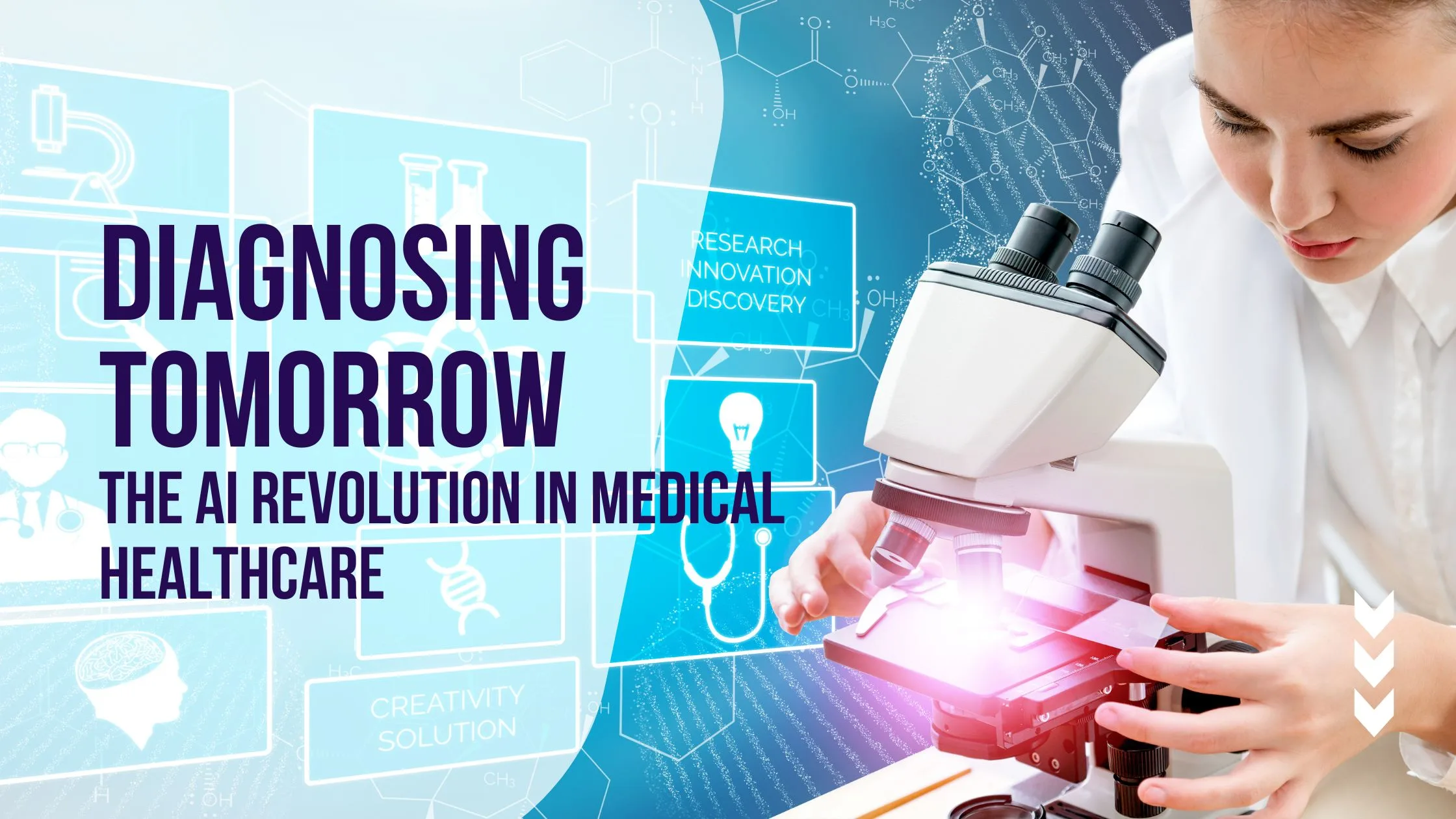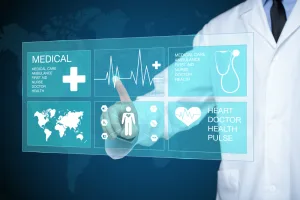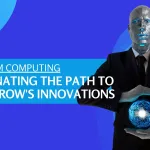Diagnosing Tomorrow: The AI Revolution in Medical Healthcare
Introduction
The intersection of technology and healthcare has yielded remarkable advancements throughout history, and now, we stand at the precipice of another groundbreaking leap – the integration of artificial intelligence (AI) into medical diagnostics. The marriage of AI’s computational prowess with the intricacies of medical science is reshaping the landscape of healthcare, offering improved accuracy, efficiency, and accessibility in the diagnostic process. In this article, we’ll delve into how AI is ushering in a new era of medical diagnostics, transforming the way we approach disease detection, patient care, and overall well-being.
In the ever-evolving landscape of healthcare, a groundbreaking revolution is underway, poised to transform the way medical diagnostics are conducted. Artificial Intelligence (AI), once confined to the realm of science fiction, has now become an integral part of modern medicine. With its ability to process vast amounts of data, recognize patterns, and make intelligent decisions, AI is playing a pivotal role in revolutionizing medical diagnostics and ultimately improving patient outcomes.
The Power of AI in Medical Diagnostics
Traditional medical diagnostics have long relied on the expertise of skilled professionals to interpret medical images, analyze lab results, and identify potential diseases. However, the human capacity for analysis is limited by time, resources, and the sheer complexity of medical data. This is where AI steps in, offering an unprecedented capacity to handle and make sense of enormous datasets with remarkable speed and accuracy.
One of the primary advantages of AI lies in its ability to detect subtle patterns that might escape even the most experienced human eye. For instance, in medical imaging, AI algorithms can identify minuscule anomalies in X-rays, MRIs, and CT scans that could signify the early stages of diseases like cancer or neurological disorders. This early detection can dramatically increase the chances of successful treatment and recovery.
The Current Diagnostic Landscape
Traditional medical diagnostics have long relied on the expertise of healthcare professionals, involving extensive manual analysis of patient data, medical history, and diagnostic images. While effective, this approach has its limitations, including the potential for human error, time-intensive processes, and discrepancies in interpretation.
The AI Advantage in Diagnostics
- Enhanced Accuracy: AI algorithms can analyze vast datasets and medical images with unparalleled accuracy. They can detect subtle patterns, anomalies, and correlations that might be imperceptible to the human eye, leading to earlier and more accurate diagnoses.
- Efficiency and Speed: AI can process and analyze medical information in a fraction of the time it would take a human expert. This efficiency can expedite the diagnostic process, crucial in cases where rapid intervention is necessary.
- Personalized Medicine: AI can process individual patient data, such as genetic information and medical history, to tailor diagnoses and treatment plans to each patient’s unique needs, optimizing outcomes.
- Remote Diagnostics: With telemedicine on the rise, AI-powered diagnostic tools can facilitate remote consultations and assessments, providing medical care to individuals in underserved or remote areas.
Applications of AI in Medical Diagnostics
- Radiology and Imaging: AI algorithms excel at analyzing medical images, such as X-rays, MRIs, and CT scans, identifying abnormalities and assisting radiologists in making more accurate interpretations.
- Pathology: AI can aid pathologists in identifying cancerous cells in tissue samples, potentially reducing errors and expediting diagnoses.
- Cardiology: AI-powered algorithms can analyze heart rhythms, ECGs, and other cardiac data to predict cardiovascular events and suggest appropriate interventions.
- Dermatology: AI-driven image analysis can assist dermatologists in diagnosing skin conditions, potentially improving the early detection of skin cancers.
- Predictive Analytics: AI can analyze patient data to predict disease risks and outcomes, enabling proactive interventions to prevent or manage conditions.
Challenges and Considerations
While the potential of AI in medical diagnostics is immense, several challenges must be navigated:
- Data Privacy: Handling patient data requires strict adherence to privacy regulations to ensure patient confidentiality and data security.
- Bias and Interpretability: AI algorithms must be carefully designed to mitigate biases and provide transparent explanations for their diagnoses.
- Human Collaboration: AI should be viewed as a tool that complements human expertise rather than replaces it. Collaborative efforts between AI and healthcare professionals are essential.
AI in Medical Imaging
Medical imaging, a cornerstone of modern diagnostics, has experienced a paradigm shift with the integration of AI. AI-powered image analysis algorithms can swiftly process complex images, highlight abnormalities, and even predict the progression of diseases based on patterns they’ve learned from vast datasets.
For instance, in radiology, AI algorithms have demonstrated remarkable accuracy in detecting various conditions. In some cases, AI has shown the potential to outperform human radiologists in identifying certain abnormalities. This doesn’t replace radiologists, but rather enhances their capabilities, allowing them to focus on more complex cases and improving overall diagnostic accuracy.
Predictive Analysis and Early Intervention
AI’s capabilities extend beyond image analysis. Machine learning algorithms can analyze patient data, from medical history and genetics to lifestyle factors, to predict the likelihood of certain diseases. By identifying high-risk individuals, healthcare providers can intervene earlier, offering preventive measures and personalized treatment plans.
Consider the example of diabetes. AI can analyze data from multiple sources to predict the likelihood of an individual developing diabetes. Armed with this information, healthcare professionals can work with patients to implement lifestyle changes that reduce the risk of disease onset.
Challenges and Considerations
While the potential of AI in medical diagnostics is immense, there are challenges that need to be addressed. One of the major concerns is the need for robust and diverse datasets. AI algorithms learn from data, and if the data used is skewed or incomplete, it can lead to biased outcomes. Ensuring that AI systems are trained on representative data from various demographics is crucial to avoiding bias and ensuring equitable diagnostics.
Additionally, the “black box” nature of some AI algorithms can raise questions about transparency and accountability. Understanding how AI arrives at a particular diagnosis or prediction is essential for building trust between medical professionals, patients, and AI systems.
The Human-AI Partnership
It’s important to note that AI is not a replacement for healthcare professionals. Instead, it’s a powerful tool that can enhance their capabilities. The ideal future lies in a symbiotic relationship between humans and AI, where medical professionals use AI-generated insights to make more informed decisions, while patients receive more accurate diagnoses and personalized treatment plans.
Looking Ahead
The future of medical diagnostics is undoubtedly intertwined with the rise of AI. As AI technology continues to advance, we can expect even more precise and early diagnoses, leading to improved patient outcomes and a more efficient healthcare system overall.
In conclusion, the AI revolution in medical diagnostics is not a distant dream but a rapidly evolving reality. By harnessing the power of AI, healthcare professionals can unlock insights hidden within vast datasets, predict disease onset, and ultimately save lives through early intervention. While challenges exist, the potential benefits are immense, heralding a new era of healthcare that is data-driven, proactive, and patient-centered. As we stand on the brink of this transformation, it’s clear that the future of medical diagnostics is one where AI plays a pivotal role in shaping healthier lives for all.
The Road Ahead
The AI revolution in medical diagnostics is already underway, and its trajectory is promising. As technology continues to evolve, AI systems will become more sophisticated, capable of handling even more complex diagnostic tasks. However, it’s crucial to approach this revolution with ethical considerations, patient well-being, and regulatory compliance at the forefront.
Conclusion
The fusion of artificial intelligence with medical diagnostics is revolutionizing the healthcare landscape. The capabilities of AI to analyze and interpret medical data with unparalleled accuracy and speed have the potential to transform the way diseases are detected, treated, and managed. As we embrace this new era of healthcare, collaboration between technology and medical professionals will drive innovation, improve patient outcomes, and pave the way for a healthier tomorrow. The future of medical diagnostics is here, and it’s powered by AI.





